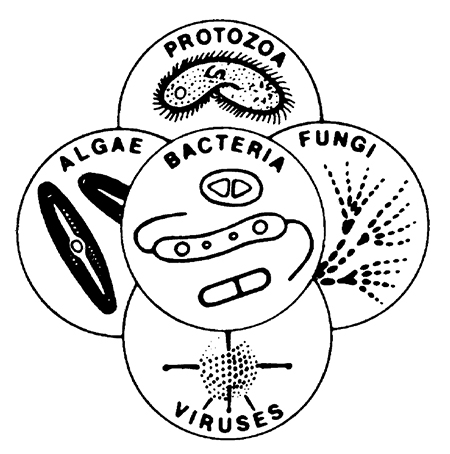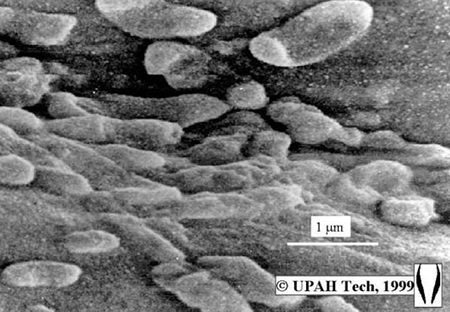Processes controlled by microorganisms can occur aerobically or anaerobically

Microorganisms are of major importance in aquaculture. They reside in the sediment and other substrates, and in the water of aquaculture facilities, as well as in and on the cultured animals. Microorganisms may have positive or negative effects on the outcome of aquaculture operations. Positive microbial activities include elimination of toxic materials such as ammonia, nitrite, and hydrogen sulfide, degradation of uneaten feed, and nutrition of aquatic animals such as shrimp and other grazing and filter feeding animals.
Deleterious effects include diseases; production of toxic ammonia, nitrite, and hydrogen sulfide; and consumption of large quantities of oxygen, which must be replenished by the aquafarmer. These and other functions make microorganisms key players in the health and sustainability of aquaculture.
Yet, microorganisms are among the least known and understood elements in aquaculture. Like other areas in aquaculture, microorganisms require management and manipulation. In a series of articles that begins with this one, we will provide examples that illustrate how to manipulate these mostly unseen, highly diverse, and extremely important agents.
Major microbial groups
The world of microorganisms is made of bacteria, fungi, algae, protozoa and viruses (Fig. 1). They are grouped together only because of their small size, and not by their function. If, for example, the same taxonomical rules were applied to larger animals, some fish, shrimp, green plants, birds and mammals would be grouped together. Some microorganisms such as viruses, bacteria, and protozoa are notoriously small, under one mm. Others, like algae and fungi, have large size relatives (such as the brown alga that is among the largest living organisms). Unlike larger organisms, the morphology of microorganisms is relatively poor and is confined to few shapes and colors. However, their poor morphology is compensated by great physiological versatility.
Viruses
Viruses are very small, ranging between 0.01 and 0.3 microns, and only visible by using an electron microscope. They can not live independently, and only multiply inside the cells of other organisms. However, their demand for a host is fairly specific. For example, it is unlikely that a crustacean virus will attack humans or fish. Viruses are also the simplest of all organisms and are made of a nucleic acid (either DNA or RNA), frequently coated with a protein layer.
Algae
Algae are photosynthetic organisms (contain chlorophyll) and obtain their energy from the sun and their carbon from carbon dioxide. Their size ranges from one micron to many meters. All organisms that use carbon dioxide for their carbon requirement are called autotrophs. Algae are generally beneficial in aquaculture by supplying oxygen and a natural food base for the cultured animals. But some algae, although free-living, can be harmful by producing toxins that are lethal to aquatic animals, such as dinoflagellates that cause the red tides.
Fungi
Fungi are similar to algae, but they do not contain chlorophyll and require pre-formed organic matter as energy and carbon sources (e.g., sugars, fats, proteins, and carbohydrates). Such organisms are called heterotrophs. Fungi, ranging in size from a few microns to several centimeters, grow either independently by feeding on decaying matter, or in association with plants and animals, frequently as parasites.
Protozoa
Protozoa are also heterotrophs, mostly free-living, feeding mainly by devouring smaller microorganisms. Their size ranges between two and 200 micrometers. A large group of protozoa, the Sporozoa, are parasites. Small numbers of protozoa contain chlorophyll and can switch between autotrophic and heterotrophic modes of feeding, based on light conditions.
Bacteria

Bacteria range in size from 0.1 to 15 microns (Fig. 2), with some “giants” that may reach half a millimeter. They make up the most metabolically diverse group of living organisms. Although some are parasitic to animals and plants, the majority of bacteria are free-living, having either a neutral or beneficial relationship with humans and other animals and plants.
Their metabolic versatility is incredible: while most are heterotrophs, they have members that live only as autotrophs, using either light or chemical energy. One of their most remarkable characteristics is their ability to multiply rapidly, with generation times usually ranging between minutes to hours.
Microbial processes
Bacteria and other microorganisms, most notably fungi, are able to metabolize and transform numerous organic and inorganic compounds. Therefore, man has used them for thousands of years for making yogurt, pickles, bread, cheese and wine, and more recently for waste treatment and water purification.
Processes controlled by microorganisms can occur aerobically (in the presence of oxygen) or anaerobically (with no oxygen present). The starting materials and the end products of such processes vary, based on the microorganisms’ capabilities (as reflected in their genetic makeup), and the environment in which these processes occur (e.g., availability of oxygen, temperature, salinity, pH, etc.). Table 1 presents schematically some of the biochemical processes that are performed by microorganisms.
Aerobic microbial processes in aquaculture
Generally, aerobic microbial processes yield compounds which can be beneficial, and are either not toxic or have low toxicity levels in aquaculture. These processes include:
- Oxidation of organic matter to carbon dioxide, a process which is the main consumer of oxygen in aquaculture ponds or tanks.
- Oxidation of ammonia to nitrate via nitrite, which also consumes large quantities of oxygen.
- Oxidation of reduced sulfur compounds (such as hydrogen sulfide and elemental sulfur) to sulfate, a process that generally has low oxygen demand in aquaculture.
- Conversion of carbon dioxide to biomass by autotrophic bacteria (such as the nitrifying bacteria) with a relatively small amount of biomass produced in aquaculture facilities, when compared to the conversion of carbon dioxide to biomass by algae.
- Conversion of carbon dioxide to biomass by algae, with a net production of oxygen depending on the availability of light. Excluding feeding, the photosynthetic process in aquaculture is the main input of carbon source and natural food for aquatic animals.
Anaerobic microbial processes in aquaculture
Microbial anaerobic processes, if not controlled, can produce compounds that are highly toxic to cultured fish or shellfish. These processes include:
- Consumption of organic matter, without the utilization of free oxygen, resulting in products which are usually not fully oxidized (such as alcohols, organic acids).
- Reduction of nitrate and nitrite, which can yield either nitrogen gas or ammonia. In aquaculture, due to the toxicity of ammonia and nitrite, ammonia production is not welcomed, while nitrogen gas production is beneficial. However, in agriculture, the opposite is true – the conversion of nitrate and nitrite to nitrogen gas results in a loss of fertilizers.
- Reduction of sulfur compounds to hydrogen sulfide as a final product, a compound which is toxic to most animals at even very low concentrations.
In future articles, we will describe the role of microorganisms in aquaculture; the relationship between feed management, microorganisms and water quality; the microbiology of biofilters and nitrification in aquaculture; and managing the microbial ecology of aquaculture by probiotics and other methods that modify the microbial flora in aquaculture facilities.
(Editor’s Note: This article was originally published in the February 2000 print edition of the Global Aquaculture Advocate.)
Now that you've finished reading the article ...
… we hope you’ll consider supporting our mission to document the evolution of the global aquaculture industry and share our vast network of contributors’ expansive knowledge every week.
By becoming a Global Seafood Alliance member, you’re ensuring that all of the pre-competitive work we do through member benefits, resources and events can continue. Individual membership costs just $50 a year. GSA individual and corporate members receive complimentary access to a series of GOAL virtual events beginning in April. Join now.
Not a GSA member? Join us.
Authors
-
Dr. Ami Horowitz
UPAH Tech, Inc.
Aquaculture and Environmental Microbiology
3666 Stoer Rd.
Shaker Heights, Ohio 44122 USA
upahtech@yahoo.com -
Dr. Sarah Horowitz
UPAH Tech, Inc.
Aquaculture and Environmental Microbiology
3666 Stoer Rd.
Shaker Heights, Ohio 44122 USA
upahtech@yahoo.com
Tagged With
Related Posts

Responsibility
Microorganisms and feed management in aquaculture
Shrimp are the most commercially important aquaculture animals that utilize a significant amount of microorganisms in their diet.

Responsibility
Improving biofiltration in recirculating aquaculture systems
The design and operation of biofilters is multidisciplinary, involving mechanical engineering, microbial ecology and aquaculture husbandry.

Health & Welfare
Bacterial, chemical residues impact tilapia quality
Both bacterial pathogens and chemical residues can affect the quality of farmed tilapia products. In production systems, Vibrio bacteria quickly proliferate following disease outbreaks.

Health & Welfare
Concerns over antibiotics, chemicals in aquaculture
When an antibiotic is administered, the usual effective dose may be insufficient to control an infection if the invasive microorganism has developed resistance.


